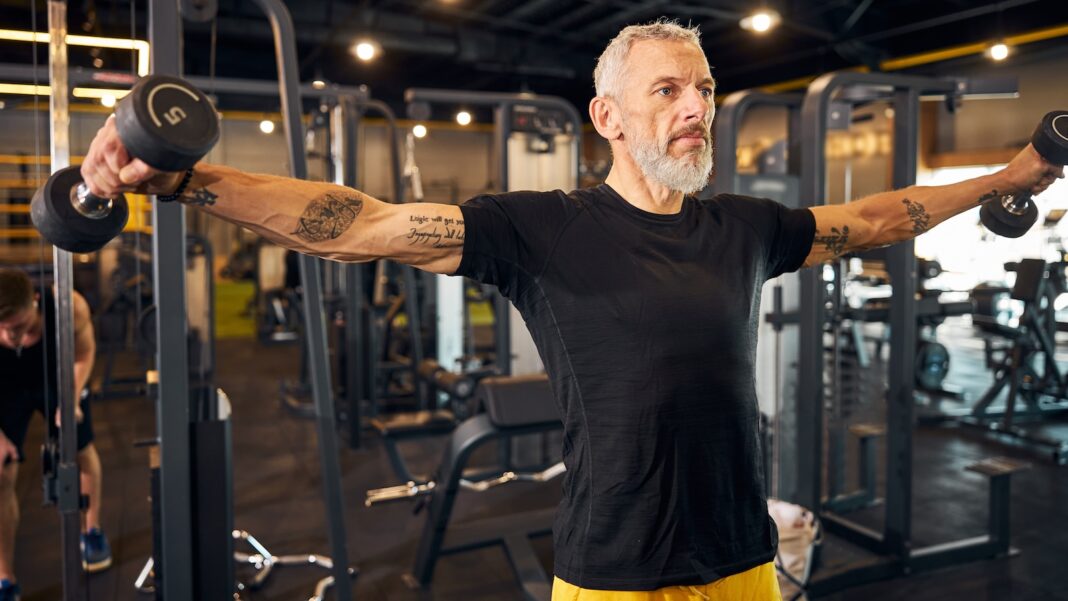The Most Effective Ways to Build the Medial Deltoids
The House of Hypertrophy (HoH) recently examined the first study to compare muscle growth from cable versus dumbbell lateral raises. These variations isolate the medial head of the deltoids, pivotal to the X-frame physique or hourglass aesthetic.
While both exercises involve arm abduction (lifting arms laterally), they have slightly different resistance profiles. Standing cable laterals offer a better stretch at the bottom, which makes them a little more challenging to start. Dumbbells are the opposite. Does that matter for growth?
The Study on Dumbbells vs. Cables
Twenty-four volunteers (16 men and eight women) with an average of 7.1 years of training experience participated in this study. They were randomly assigned cable lateral raises to one arm and dumbbell lateral raises for the other arm using wrist cuffs to rule out grip fatigue. Both variations were performed from 0-to-90 degrees, with arms angled slightly forward for shoulder comfort. Cables were aligned with hands in the starting position, with arms by sides. Cable raises are more challenging in the starting position when the medial delts are most lengthened; dumbbell laterals are most challenging at 90 degrees.
Five sets per exercise to failure in the 12-16 rep range were performed twice weekly for eight weeks. They progressively overloaded the movements over the study’s duration.
"This design of all subjects training both exercises is great as differences in genetics, nutrition, and outside lifestyle factors are less likely to confound the findings," HoH explained.
Which Is Better?
Data from the study revealed that "Both dumbbell and cable lateral raises are similarly effective for increasing lateral deltoid muscle hypertrophy in resistance-trained lifters."
Use caution when forming conclusions from a single study. Increasing the range of motion and rep tempo might skew the results.
Muscle Length and Hypertrophy
Several recent studies comparing hypertrophy used different training variables in three categories:
- Resistance Challenge: Exercises are most challenging when muscles are lengthened versus shortened.
- Range of Motion: Full vs. partial range of motion.
- Biarticular Muscles: Muscles crossing two joints.
Resistance Challenge
Since the medial delt study is most similar to the resistance challenge, compare it to the only equivalent study from 2020, comparing barbell preacher curls, which are more challenging when the arms are extended, to cable preacher curls, which are more challenging during contraction. There was virtually no difference in growth.
Range of Motion
Science conflicts regarding full range of motion versus partial reps. A few studies deemed stretched partials better than full-motion reps, but the subjects were untrained. Data on trained individuals observed that both similarly maximize hypertrophy. From this data, training at longer lengths, while effective, isn’t necessarily superior for hypertrophy.
Biarticular Muscles
A study comparing growth in the quadriceps, a biarticular muscle, using different joint angles during leg extensions, found that the rectus femoris — the only quad crossing both the hip and knee joints — grows better with a reclined torso. This, combined with adjusting the leg lever back under the seat, optimally lengthens the rectus femoris.
Best for Muscle Gains
While the research isn’t entirely conclusive, HoH’s "suspicion is [biarticular muscles] is the category where trained individuals will see better growth from longer muscle lengths."
Burke and colleagues’ 2024 article demonstrates better calf growth from standing versus seated calf raises in trained individuals. The takeaways are, "Don’t be afraid to experiment; training hard with enough volume and consistency are the most important things for building muscle," HoH concluded.
More in Research
References
- Larsen, S., Wolf, M., Schoenfeld, B. J., Sandberg, N. Ø., Fredriksen, A. B., Kristiansen, B. S., … Falch, H. N. (2024). Dumbbell versus cable lateral raises for lateral deltoid hypertrophy: an experimental study. Retrieved from https://sportrxiv.org/index.php/server/preprint/view/487#:~:text=In%20conclusion%2C%20our%20data%20suggests,hypertrophy%20in%20resistance%2Dtrained%20lifters.
- Nunes, J. P., Jacinto, J. L., Ribeiro, A. S., Mayhew, J. L., Nakamura, M., Capel, D. M. G., Santos, L. R., Santos, L., Cyrino, E. S., & Aguiar, A. F. (2020). Placing Greater Torque at Shorter or Longer Muscle Lengths? Effects of Cable vs. Barbell Preacher Curl Training on Muscular Strength and Hypertrophy in Young Adults. Journal of Science in Sport and Exercise, (16), 5859. https://doi.org/10.3390/ijerph17165859
- Wolf, M., Korakakis, P. A., Piñero, A., Mohan, A. E., Hermann, T., Augustin, F., … Schoenfeld, B. J. (2024). Lengthened Partial Repetitions Elicit Similar Muscular Adaptations as a Full Range of Motion During Resistance Training in Trained Individuals. Retrieved from https://sportrxiv.org/index.php/server/preprint/view/455
- Mitsuya, H., Nakazato, K., Hakkaku, T., & Okada, T. (2023). Hip flexion angle affects longitudinal muscle activity of the rectus femoris in leg extension exercise. Journal of Science in Sport and Exercise, (6), 1299–1. https://doi.org/10.1007/s00421-023-05156-w
- Maeo, S., Wu, Y., Huang, M., Sakurai, H., Kusagawa, Y., Sugiyama, T., Kanehisa, H., & Isaka, T. (2023). Triceps brachii hypertrophy is substantially greater after elbow extension training performed in the overhead versus neutral arm position. Journal of Science in Sport and Exercise, (7), 1240–1250. https://doi.org/10.1080/17461391.2022.2100279
- Kinoshita, M., Maeo, S., Kobayashi, Y., Eihara, Y., Ono, M., Sato, M., Sugiyama, T., Kanehisa, H., & Isaka, T. (2023). Triceps surae muscle hypertrophy is greater after standing seated calf-raise training. Journal of Science in Sport and Exercise, 1272106. https://doi.org/10.3389/fphys.2023.1272106
- Burke, Ryan & Piñero, Alec & Mohan, Adam & Hermann, Tom & Sapuppo, Max & Augustin, Francesca & Coleman, Max & Androulakis-Korakakis, Patroklos & Wolf, Milo & Swinton, Paul & Schoenfeld, Brad. (2024). Exercise Selection Differentially Influences Lower Body Regional Muscle Development. Journal of Science in Sport and Exercise. 10.1007/s42978-024-00299-4.




